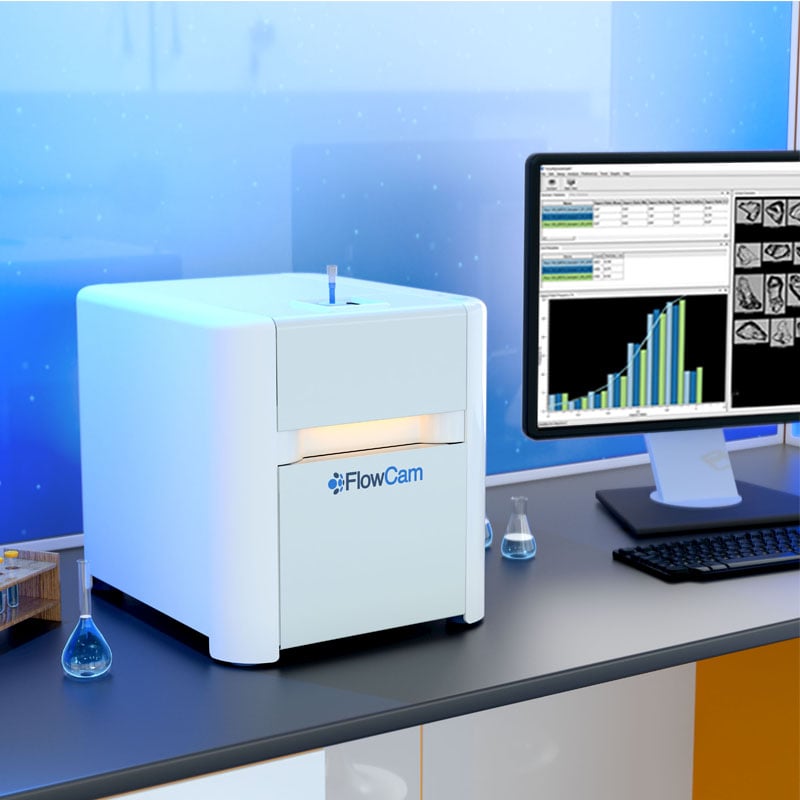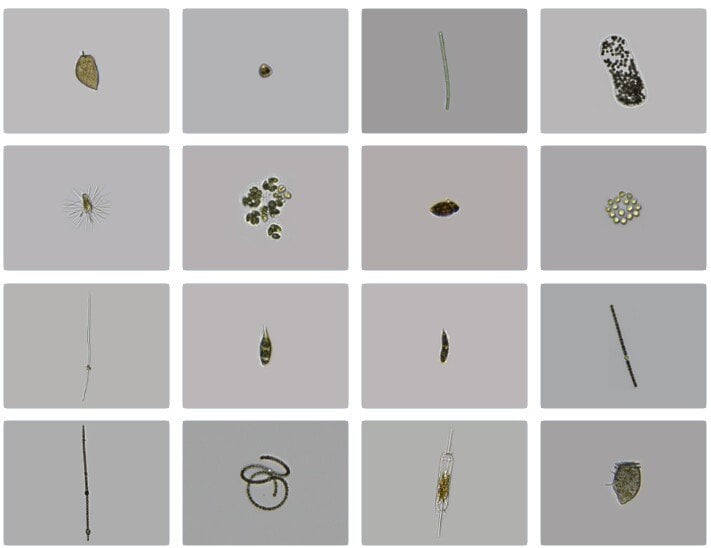We are excited to announce our new phytoplankton identification gallery, which will assist FlowCam users working with phytoplankton in marine research, freshwater quality monitoring, and other aquatic applications. This gallery provides example FlowCam images to assist users with the taxonomic identification of common algal groups in freshwater, estuarine, and marine systems. These high-quality color FlowCam images complement traditional taxonomy resources and are especially useful for new users and early-career analysts.
The gallery includes taxa of particular interest to researchers, managers, and regulatory agencies. These include potentially toxigenic (PTOX) taxa, cyanobacteria, problematic taste and odor producers (T&O), shellfish HABs, and other nuisance algae groups. Using key morphological features visible in FlowCam images, the guide may be used to assist with the taxonomic identification of phytoplankton* for groups working with FlowCam image data.
Explore the Phytoplankton Identification Gallery
What Are Phytoplankton?
“phyto” – plant
“plankton” – made to wander or drift
Phytoplankton are microscopic organisms common in aquatic habitats that spend either all or part of their life cycle in the water column. Like terrestrial plants, they contain chlorophyll, require sunlight to live and grow, and produce oxygen through photosynthesis.
Most taxa have life stages that exist as active organisms in the water and as cysts (resting cells) in the substrate. Existing as single-celled, colonial, or filamentous, their cells are adapted for life in the water column and are able to remain buoyant to float in the upper part of the water column where sunlight penetrates.
There are approximately 5,000 marine species of phytoplankton within 10 major taxonomic groups, including silica-encased diatoms, dinoflagellates, cyanobacteria, chalk-coated coccolithophores, and green algae. These include 89 toxin-producing species, primarily dinoflagellates. There are approximately 15,000 freshwater species, including over 55 toxin-producing species (mostly cyanobacteria).

Different algal groups. Image credit: NASA EOS Project Science Office / Sally Bensusen
Why Study Phytoplankton and Algae?
Scientists, natural resource managers, and regulatory agencies study phytoplankton for many reasons. Knowing what organisms are present and what risks they may pose is essential. Monitoring algal communities is an effective way to assess water quality, environmental conditions, and public health risks in drinking water reservoirs, recreational waters, and shellfish growing areas.
Different taxa have different habitat preferences and stress tolerances, making them useful bioindicators. Long-term trends in community structure can be used to classify the trophic status of bodies of water, and short-term disruptions may be used as an early warning sign that reflects a body of water's health. This is particularly important for drinking water utilities, managers of recreational waters, and shellfish sanitation programs, especially during a harmful algal bloom (HAB) event.
What is an Algal Bloom?
Phytoplankton form the foundation of complex food webs and drive the microbial loop in aquatic systems. They are also capable of rapidly proliferating their numbers over short periods in a phenomenon known as blooms. When too many nutrients are available, along with warm temperatures and ample sunlight, phytoplankton can grow explosively and form harmful algal blooms. Blooms may:
- discolor the water, turning it red, brown, green, or even a milky blue
- form scums, gelatinous blobs, or benthic mats
- produce toxic compounds that have harmful effects on fish, shellfish, mammals, birds, and even people
- lead to massive dead zones after large bloom die-offs.
 Large bloom of the bioluminescent dinoflagellate Alexandrium monilatum in 2020 on the York River, VA. Inset: FlowCam images of A. monilatum. Image credits Savannah Mapes, VIMS.
Large bloom of the bioluminescent dinoflagellate Alexandrium monilatum in 2020 on the York River, VA. Inset: FlowCam images of A. monilatum. Image credits Savannah Mapes, VIMS.
Visualizing Phytoplankton Morphology with FlowCam
It is important to accurately identify the organisms present in a water body to monitor the effects of different types of algae. The images chosen for this gallery are representative of the main algal groups studied by FlowCam users: cyanobacteria, diatoms, dinoflagellates, green algae, and golden algae. FlowCam images readily capture many morphological features required for identification.
For example, the Chaetoceros (A) image below clearly displays the spines arising from each valve, called setae, a unique morphological feature of these chain-forming centric diatoms. The narrow and boat-shaped cells of the pennate diatom Pseudo-nitzschia (B) visibly show the way the chains are formed with overlapping of the valve ends. The Microcystis colony (C) shows the distinct dark cells that indicate aerotopes within a thick mucilage, characteristic of this taxon group. These are all morphological features that can be used to classify phytoplankton from FlowCam images.
A.  B.
B.  C.
C. 
Example images from the new phytoplankton gallery: (A) Chaetoceros sp. (B) Pseudo-nitzschia sp. (C) Microcystis sp.
Navigating the Phytoplankton Image Gallery
Each image also has data associated with its habitat and harmful effects. Using the search box at the top left, as well as the filters to the left of the image thumbnails, the gallery is searchable by habitat (freshwater, estuarine, and marine) and harmful effects:
- CTI coagulation treatment interference
- ED ecosystem disrupter
- FC filter clogger
- HS hinders settling
- PTOX potentially toxigenic
- SP slime producing
- T&O taste and odor producer
- WS water softening effects
To learn more about how FlowCam can support your phytoplankton research and monitoring, download our ebook, "The Ultimate Guide to Flow Imaging Microscopy for Aquatic Life Sciences".
Explore the Phytoplankton Identification Gallery
Do you have images to add to our gallery?
Users who would like to contribute their own FlowCam images to this guide can submit images to info@fluidimaging.com. Priority will be given to images that clearly show the morphological features that can be used to identify them.
Please include your taxonomic identification to the lowest taxonomic level possible, the general habitat (freshwater, estuarine, and/or marine) and location (body of water, county, state, country) where the sample was collected, date, and the name of the person to whom credit should be attributed. Images should be submitted in PNG format, exported directly from VisualSpreadsheet. Images may be used in marketing and outreach materials in addition to inclusion in the Phytoplankton Identification Image Gallery.
*Note that morphology and community composition may vary based on your location, environmental conditions, and instrument settings. This guide is designed to be a general resource and should not be used exclusively for making public health decisions. Images are not to scale. FlowCam is not designed for speciation, though it may be possible depending on your area and the genera you are working with.
References: Berk, S. G., J. H. Gunderson (1993), Chorus, I., M. Welker (2021); Palmer, C. M. (1962); Palmer, C. M. (1980); Shumway, S. E.; J. M. Burkholder, S. L. Morton (2018); Steidinger, K. A., M. E. M. del Castillo (2018).











